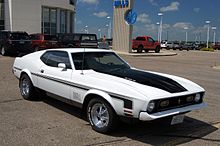Mach 1
First generation Mustang Facelift (1971–1973)
For 1971, Ford reduced the content of the Mach 1. The standard features of the model were as follows:
- SportsRoof body style with unique “05” VIN code & “63R” body code on door tag
- Color-keyed urethane front “spoiler” bumper & front fender and hood trim
- Honeycomb grille in black w/sportlamps
- Argent or black “Mach 1 – MUSTANG” decals on fenders
- Argent or black stripe and “Mach 1” decal on the trunklid
- Argent or black lower body accent paint
- Bright trim at lower body paint line
- E70-14 white sidewall tires w/ hub caps & trim rings on 7″ wide steel wheels
- Color-keyed dual racing mirror w/driver side remote
- Honeycomb taillight panel applique with bright trim
- Unique pop open gas cap
- F-code 302-2V engine w/3 speed manual transmission
- Competition Suspension (HD springs & shocks), variable quick-ratio steering box if ordered with P/S
- Base Mustang vinyl interior
- Flat hood – the NACA scooped hood was a no-cost OPTION for the base engine
In 1971, the Mach 1 was available with three 351 Cleveland engines; the H-code 2-V, the M-code 4-V and beginning in May of 1971, the Q-code 351CJ (Cobra Jet or GT engine). M & Q code engines were produced concurrently up until the end of 71 model year production. There were also two 429ci options, the C-code CJ (Cobra Jet) & J-code CJ-R (Cobra Jet – Ram Air). Buying the optional “Drag Pak” 3.91 (V) or 4.11 (Y) rear gears turned either 429 into a “Super Cobra Jet”, with solid lifter cam, Holley 780cfm carb and special rotating assembly with forged pistons.
One of the most recognizable features of the ’71-’73 Mach 1s is the hood design with dual scoops. The hood was a no cost option on the 302 cars and standard on all others. The basic NASA hood came as a non-functional item, but when ordered with the Ram Air option, it became truly functional. The Ram Air option included a vacuum controlled door inside each scoop, and a fiberglass under-hood ‘plenum’ that directed cool, outside air through a modified, rubber-ringed air filter housing and into the carburetor. The ram-air option also included a pair of 1970 Mach1-style chrome twist hood locks and a two-tone hood paint treatment in either ‘matte black’ or ‘argent’ (matte silver), which coordinated with the decals and striping. The option also received either a “351 RAM AIR” or “429 RAM AIR” decal on each side of the hood, depending upon the engine ordered.
In 1972, the 429CJ & SCJ engines were dropped from the lineup, and horsepower ratings dropped across the board due to the switch to new SAE net horsepower calculations and a 4 degree camshaft retard built into the timing set. This year also produced the fewest Mach 1 sales of the 1971-73 generation. There are no major differences in the ’71 and ’72 Mach 1s externally. The ’72 Mach 1 also saw deletion of the pop-open gas cap, which was replaced with the standard twist-on cap found on the other Mustang models that year. The 302 Windsor remained as the base Mach 1 engine. There were again three 351 Cleveland engine options for ’72. A 2 barrel, the 4 barrel 351CJ and a new for ’72 R-code 351HO, essentially a lower compression Boss 351 engine.

1971 Ford Mustang Mach 1
The Mach 1 received some significant appearance updates for 1973. The lower body accent paint and bright trim were gone and the entire car was one color top to bottom. All ’73 Mach 1s received a wide body-side tape stripe in either black or argent, that featured a “MACH 1” cutout on the front of the quarter panel, and a standard “MUSTANG” script emblem on the fender. The deck lid tape stripe was revised, with the “MACH 1” lettering now incorporated into the passenger side of the stripe, instead of centered above it as in 71 & 72. The valance cutouts and bright tips were no longer available on 4V cars for 1973.
The Mustang needed to comply with new NHTSA standards, which necessitated a redesigned front and rear bumper. The front bumper on all models was now a much larger body-colored urethane unit, mounted on impact absorbing struts. Due to the revised bumper, the Mach 1 sportlamps were deleted and all models had the park/turn signal lamps moved from the front valance up to a vertical orientation at each end of the grille. The Mach 1 grille was black with a honeycomb pattern and a small running horse tri-bar emblem. The rear bumper was mounted on extended brackets which caused the bumper to protrude from the body further and yielded a large gap. To rectify this, Ford used a body colored urethane filler piece at each quarter panel, and a sheetmetal filler panel bolted to the taillight panel.
Engine options remained virtually the same as in 1972, with the exception of the 351HO being dropped. The 351-4V was not advertised in the ’73 Mustang as a Cobra Jet engine even though the 1973 Ford shop manual and other internal Ford documentation did reference the engine as the 351-4V CJ since the “Cobra Jet” nomenclature did continue on in Torino, Cougar and Montego lines.
Due to trouble getting the Ram Air option approved for emissions reasons, the 351-2V was the only engine available with Ram Air. New for ’73, Ford offered a “Tu-Tone” hood paint treatment option that consisted of the black or argent paint treatment and twist locks, but without the actual functional components of the Ram Air system.